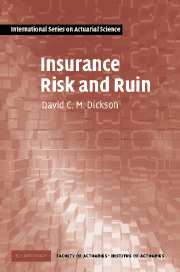Crossref Citations
This Book has been
cited by the following publications. This list is generated based on data provided by Crossref.
Chan, Wai-Sum
and
Zhang, Lianzeng
2006.
Direct Derivation of Finite-Time Ruin Probabilities in the Discrete Risk Model with Exponential or Geometric Claims.
North American Actuarial Journal,
Vol. 10,
Issue. 4,
p.
269.
Dickson, D. C. M.
and
Drekic, S.
2006.
Optimal Dividends Under a Ruin Probability Constraint.
Annals of Actuarial Science,
Vol. 1,
Issue. 2,
p.
291.
Zhou, Ming
Wei, Li
and
Guo, Jun-yi
2006.
Some Results behind Dividend Problems.
Acta Mathematicae Applicatae Sinica, English Series,
Vol. 22,
Issue. 4,
p.
681.
Gerber, Hans U.
Shiu, Elias S.W.
and
Smith, Nathaniel
2006.
Maximizing Dividends without Bankruptcy.
ASTIN Bulletin,
Vol. 36,
Issue. 1,
p.
5.
Boudreault, Mathieu
Cossette, Hélène
Landriault, David
and
Marceau, Etienne
2006.
On a risk model with dependence between interclaim arrivals and claim sizes.
Scandinavian Actuarial Journal,
Vol. 2006,
Issue. 5,
p.
265.
Gerber, Hans U.
Shiu, Elias S.W.
and
Smith, Nathaniel
2006.
Maximizing Dividends without Bankruptcy.
ASTIN Bulletin,
Vol. 36,
Issue. 1,
p.
5.
Albrecher, Hansjörg
Hartinger, Jürgen
and
Thonhauser, Stefan
2007.
On Exact Solutions for Dividend Strategies of Threshold and Linear Barrier Type in a Sparre Andersen Model.
ASTIN Bulletin,
Vol. 37,
Issue. 2,
p.
203.
Alfa, Attahiru Sule
and
Drekic, Steve
2007.
Algorithmic Analysis of the Sparre Andersen Model in Discrete Time.
ASTIN Bulletin,
Vol. 37,
Issue. 2,
p.
293.
Alfa, Attahiru Sule
and
Drekic, Steve
2007.
Algorithmic Analysis of the Sparre Andersen Model in Discrete Time.
ASTIN Bulletin,
Vol. 37,
Issue. 2,
p.
293.
Albrecher, Hansjörg
Hartinger, Jürgen
and
Thonhauser, Stefan
2007.
On Exact Solutions for Dividend Strategies of Threshold and Linear Barrier Type in a Sparre Andersen Model.
ASTIN Bulletin,
Vol. 37,
Issue. 2,
p.
203.
Singh, Tripti
2007.
Relationship of Leaders' Career Anchors with Transformational Leadership and Organizational Citizenship Behavior of Followers.
SSRN Electronic Journal,
Cheung, Eric C.K.
and
Drekic, Steve
2008.
Dividend Moments in the Dual Risk Model: Exact and Approximate Approaches.
ASTIN Bulletin,
Vol. 38,
Issue. 2,
p.
399.
Zhu, Mei
2008.
Der Einfluss von Cat Bonds-Emissionen auf das ökonomische Zielkapital von Schaden-/Unfallversicherungsunternehmen.
Zeitschrift für die gesamte Versicherungswissenschaft,
Vol. 97,
Issue. S1,
p.
113.
Li, Shuanming
2008.
The Time of Recovery and the Maximum Severity of Ruin in a Sparre Andersen Model.
North American Actuarial Journal,
Vol. 12,
Issue. 4,
p.
413.
Cheung, Eric C.K.
and
Drekic, Steve
2008.
Dividend Moments in the Dual Risk Model: Exact and Approximate Approaches.
ASTIN Bulletin,
Vol. 38,
Issue. 2,
p.
399.
Karapetyan, N. V.
2009.
Dividend optimization under the gamma-distribution of claims.
Moscow University Mathematics Bulletin,
Vol. 64,
Issue. 5,
p.
219.
Lefèvre, Claude
and
Loisel, Stéphane
2009.
Finite-Time Ruin Probabilities for Discrete, Possibly Dependent, Claim Severities.
Methodology and Computing in Applied Probability,
Vol. 11,
Issue. 3,
p.
425.
Ramsay, Colin M.
2009.
The distribution of compound sums of Pareto distributed losses.
Scandinavian Actuarial Journal,
Vol. 2009,
Issue. 1,
p.
27.
Paté‐Cornell, Elisabeth
and
Deleris, Léa A.
2009.
Failure Risks in the Insurance Industry: A Quantitative Systems Analysis.
Risk Management and Insurance Review,
Vol. 12,
Issue. 2,
p.
199.
Trufin, Julien
Albrecher, Hansjörg
and
Denuit, Michel
2009.
Impact of Underwriting Cycles on the Solvency of an Insurance Company.
North American Actuarial Journal,
Vol. 13,
Issue. 3,
p.
385.



